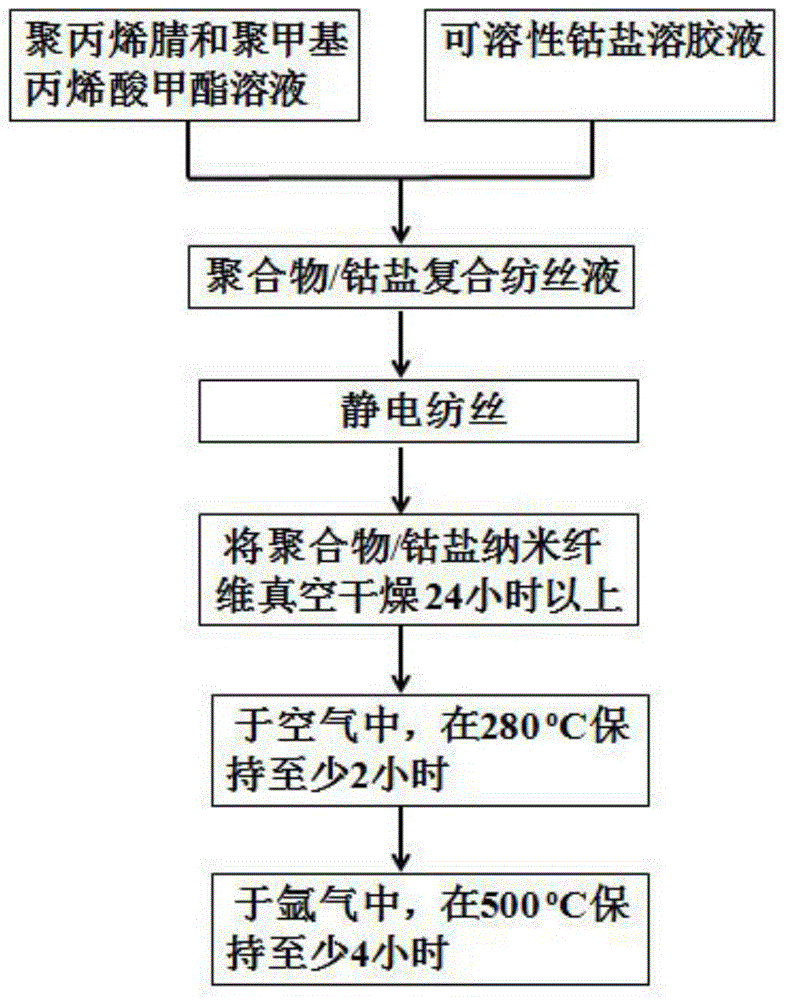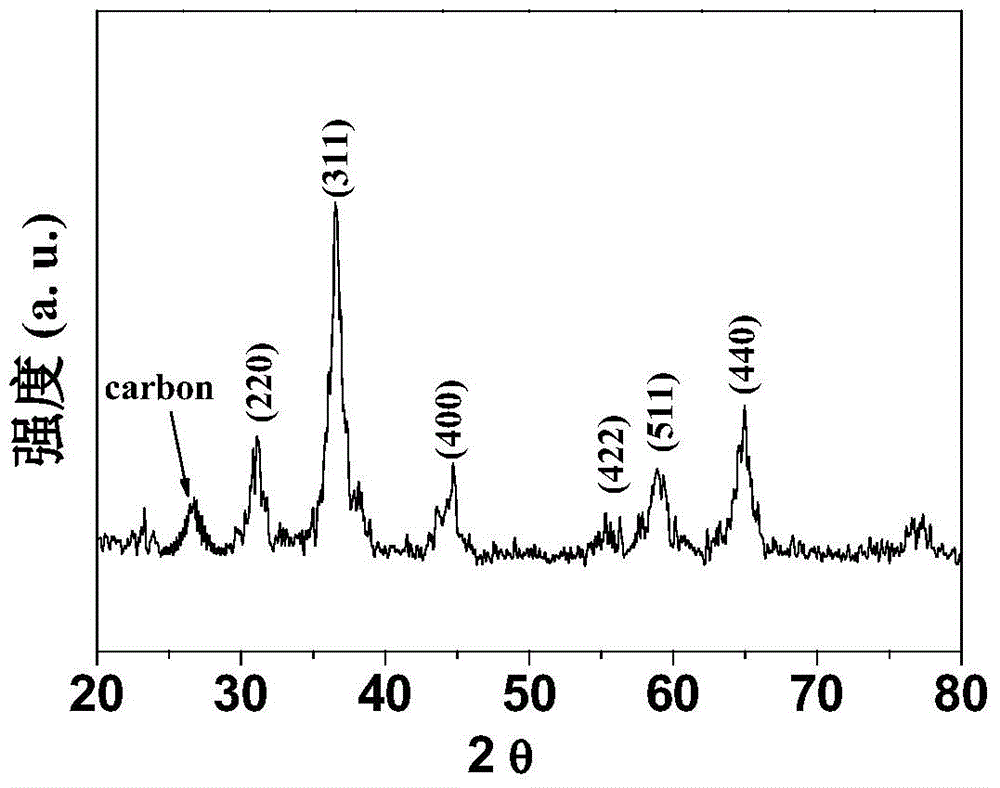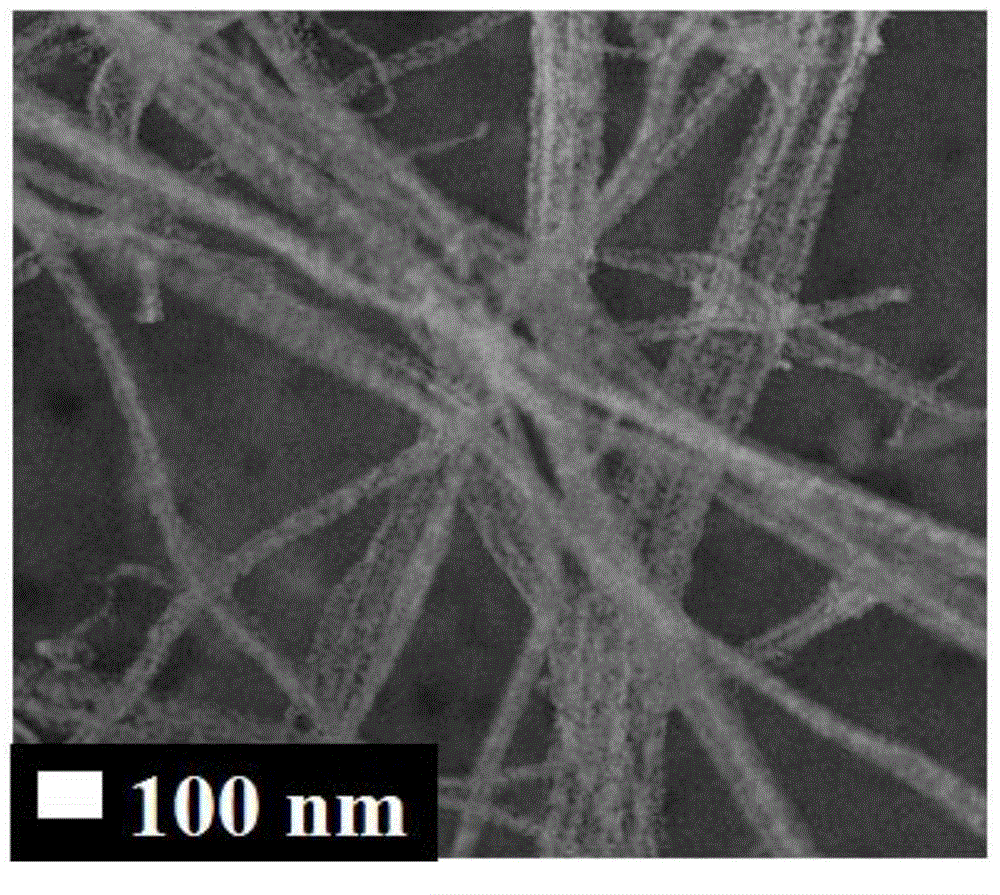Preparation method of cobaltosic oxide-carbon porous nanofiber and application of cobaltosic oxide-carbon porous nanofiber to preparation of lithium ion battery
A technology of tricobalt tetroxide and nanofibers, applied in battery electrodes, nanotechnology, nanotechnology, etc., can solve the problems of low cycle life and poor rate performance, achieve good reproducibility, improve cycle life and rate performance, and be easy to implement Effect
- Summary
- Abstract
- Description
- Claims
- Application Information
AI Technical Summary
Problems solved by technology
Method used
Image
Examples
Embodiment 1
[0021] (1) Preparation of polymer / inorganic spinning solution: Add 1g of polyacrylonitrile and 1g of polymethyl methacrylate to 19ml of dimethylformamide (dimethylformamide, density 0.945g / ml) , heated at 90°C and continuously stirred until completely dissolved to obtain a polymer dimethylformamide solution; 0.6g of cobalt acetylacetonate was added to 3.6ml of dimethylformamide and continuously stirred until dissolved to obtain an inorganic sol solution Add the inorganic sol solution dropwise to the polymer solution, and continue stirring at 80-100°C for 24 hours to obtain a polymer / inorganic composite spinning solution.
[0022] (2) Preparation of polymer / inorganic composite nanofibers loaded on aluminum foil: fix the aluminum foil to a plastic plate as a collection device, prepare polymer / inorganic composite nanofibers loaded on aluminum foil by electrospinning process, and control composite nanofibers The thickness of the fiber is 0.1-0.5mm.
[0023] (3) Preparation of tri...
Embodiment 2
[0025] (1) Preparation of polymer / inorganic spinning solution: Add 1g of polyacrylonitrile and 1g of polymethyl methacrylate to 23ml of dimethylformamide, heat at 90°C and keep stirring until completely dissolved to obtain a polymer Add 0.6g of cobalt acetate to 2.9ml of dimethylformamide, stir continuously until dissolved to obtain inorganic sol solution; add the inorganic sol solution dropwise into the polymer solution, and continue stirring at 80-100°C After 24 hours, a polymer / inorganic composite spinning solution was obtained.
[0026] Other steps are the same as in Example 1, and the diameter of the obtained composite fiber is about 90nm.
Embodiment 3
[0028] (1) Preparation of polymer / inorganic spinning solution: 1g of polyacrylonitrile and 1g of polymethyl methacrylate were added to 15.5ml of dimethylformamide, heated at 90°C and continuously stirred until completely dissolved to obtain Polymer dimethylformamide solution; add 0.6g cobalt chloride to 2.2ml dimethylformamide, stir continuously until dissolved to obtain inorganic sol; add the inorganic sol dropwise to the polymer solution, Continue stirring at 80-100°C for 24 hours to obtain a polymer / inorganic composite spinning solution.
[0029] The other steps are the same as in Example 1, and the diameter of the obtained composite fiber is about 95nm.
PUM
| Property | Measurement | Unit |
|---|---|---|
| Diameter | aaaaa | aaaaa |
| Thickness | aaaaa | aaaaa |
| Diameter | aaaaa | aaaaa |
Abstract
Description
Claims
Application Information
 Login to View More
Login to View More - R&D
- Intellectual Property
- Life Sciences
- Materials
- Tech Scout
- Unparalleled Data Quality
- Higher Quality Content
- 60% Fewer Hallucinations
Browse by: Latest US Patents, China's latest patents, Technical Efficacy Thesaurus, Application Domain, Technology Topic, Popular Technical Reports.
© 2025 PatSnap. All rights reserved.Legal|Privacy policy|Modern Slavery Act Transparency Statement|Sitemap|About US| Contact US: help@patsnap.com



